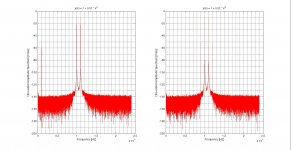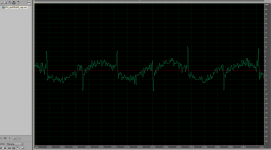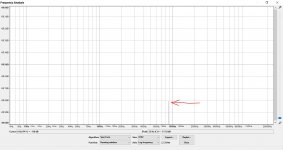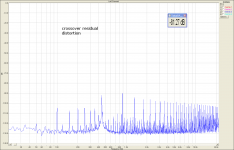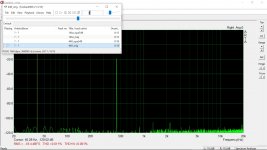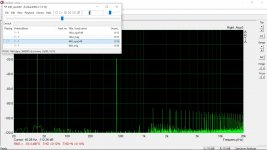Yes i know that IMD test is not very sensitive to 3rd order distortion.
No, I am trying to say that the CCIF is not sensitive to 2nd order distortion (difference tone) created by crossover distortion. The 1kHz tone, generated by 13+14kHz, 19+20kHz or so by crossover distortion is small and not well audible. As opposite, this test is more sensitive to odd harmonics which make the skirts around 2 fundamental tones.
I deeply apologize guys. Would you mind testing again?
http://pmacura.cz/1khz_549new.zip
the previous test was invalid, sorry again. The new files are synchronous and time aligned. They come from the same source generator and are made simultaneously.
Karl and others, perfect pitch discrimination, as you know, linear changes are much more audible than nonlinear changes.
I just listened to both, 2x times, on my desktop computer - internal soundchip, to cheap amplified very lo fi speakers, but adequate for 1 KHz.
The file marked OPA549 SEEMED to have a very low level ringing/fm warbling quality - the best way I can describe it is the sound of listening to CW ( morse code ) through a really, really, really, narrow filter.
My PERCEPTION is it jumped right out at me the first time I listened to it, and also the second time. Whether I could reliably A/B it, I have no idea, unfortunately.
I don't consider myself an audiophile, or golden eared. I have no idea if there is any actual difference in the files, and I simply imagined what I heard. But I have listened to a lot of CW .....
Win W5JAG
Now that is interesting. I heard this as well but put it down to using perhaps to high a level (which in reality wasn't high) and also the fact that swallowing and jaw movement seemed to make it instantly disappear.
Both files did it because I thought at the time I could ID them from this but no, both do it and I conclude its a 'listener effect' and not something present in the actual sample.
Both files did it because I thought at the time I could ID them from this but no, both do it and I conclude its a 'listener effect' and not something present in the actual sample.
* With Lacinato ABX is impossible ALL tests.
* With JRiver is very very very difficult.
With JRiver and KEF Q100 speakers:
1khz_opa549.wav vs 1khz_orig.wav
The first has less bass or more highs than the second.
440_opa549.wav vs 440_orig.wav
The first has more bass or less highs than the second.
* With JRiver is very very very difficult.
With JRiver and KEF Q100 speakers:
1khz_opa549.wav vs 1khz_orig.wav
The first has less bass or more highs than the second.
440_opa549.wav vs 440_orig.wav
The first has more bass or less highs than the second.
I have filtered the DC and the 2*wt term because this would introduce aliasing..
Not my point 1% peak nonlinearity in the transfer function produces 0.5% harmonic distortion.
Not my point 1% peak nonlinearity in the transfer function produces 0.5% harmonic distortion.
I assume that the factor 2 goes away because of the two sines at 10k and 11k?
Attachments
Back to the crossover distortion test topic - this is interesting, it is the difference between 440_orig and 440_opa549 file, with phase shift eliminated, and grossly magnified (Y axis is in samples). One can easily see the nature of the crossover distortion.
Attached is also the difference file in zip. Should be played in normal volume same as for 440Hz files.
Attached is also the difference file in zip. Should be played in normal volume same as for 440Hz files.
Attachments
I assume that the factor 2 goes away because of the two sines at 10k and 11k?
You just need to take care of the bookkeeping in differentiating between THD and IMD.
Udo, enough to read the Cabot's paper that I have posted. You will also understand which measuring method is sensitive to specific distortion mechanism.
Tried with speakers and headphones and impossible to discern it.
Tried with my "bad" amplifier and 12/12 another time. Only for curiosity I test the output for this amplifier and I get the images posted below. Harmonics are worsened much more for 440_opa549 than for 440_orig, and see H2 is lower.
Attachments
Back to the crossover distortion test topic - this is interesting, it is the difference between 440_orig and 440_opa549 file, with phase shift eliminated, and grossly magnified (Y axis is in samples). One can easily see the nature of the crossover distortion.
Attached is also the difference file in zip. Should be played in normal volume same as for 440Hz files.
This track is amplified like the image you posted, I suppose.
I never imagine the crossover distortion sounds like this. Very thanks for posting it.
It would be very interesting to hear only the crossover distortion of your opa549 amp for an audio track. Can you post any?
Thanks in advance.
I should have said zoomed rather than magnified or amplified. There was no further sound amplification used. You have to compare the extracted distortion file with the 440_orig sine file in foobar by switching between them at same volume and you will find the extracted crossover distortion inaudible. I will try to prepare the sound file with extracted crossover distortion from music, but it will need quite a lot of time. In case of Mooly's files it was easy, as they were simulated, not recorded.
- Status
- Not open for further replies.
- Home
- General Interest
- Everything Else
- Test your ears in my new ABX test

